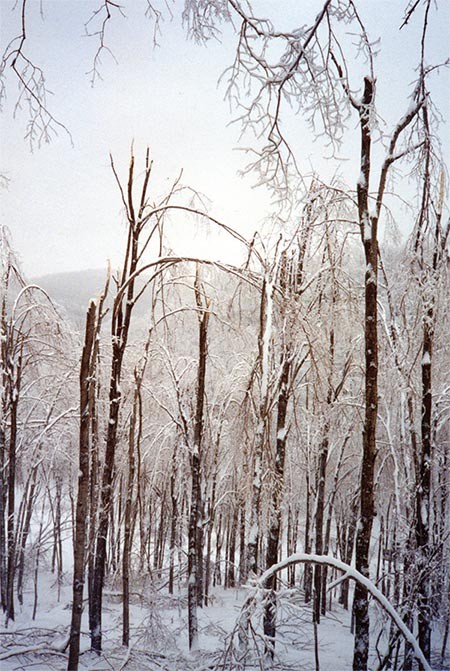
The ice storm of 1998 provided a lesson on the resilience of the northern forest.
The precipitation started falling on January 5th, and for four days the gargantuan ice storm of 1998 pounded northern New York and New England, along with southeastern Canada. Freezing rain, ice pellets, traces of snow, back to freezing rain. Meteorologists label a storm with .25 inches of ice as “disruptive;” a .5-inch layer of ice is considered a “crippling” event. During this storm, some places got ice accumulations of three inches. High winds on the back end of the storm added to the havoc.
Millions of people lost power and 40 deaths were reported region-wide. Damage estimates were pegged at three billion dollars. For many, though, it was the sight of towering trees bowed low, many splintered by the weight of the ice, which created the most powerful images of the storm. Aerial surveys revealed that some 25 million acres of forestland had been damaged throughout the Northeast.
A silver lining in all this destruction was the wealth of data that emerged on how ice storms affect the woods. Topography, forest conditions, and microclimates were all shown to have influenced the amount and severity of damage. And, even within largely uniform sites, “different degrees of damage occurred in a mosaic pattern, with patches of intense damage imbedded within larger, less damaged areas,” according to a U.S. Forest Service report.
While damage extended to virtually all tree species in the northern forests, American beech was perhaps hardest hit, a fact researchers attribute to the weakening effects of beech bark disease. Soft, brittle hardwoods, including aspen, ash, basswood, and black cherry, sustained the most damage. Softwoods had considerably less damage than hardwoods. Not surprisingly, larger-diameter trees and those in the overstory saw more damage than smaller, understory trees.
Many of the damaged stands proved remarkably resilient. Kevin Smith and Walter Shortle at the U.S. Forest Service’s Northern Research Station have been monitoring 584 northern hardwood trees across the region that had sustained various levels of crown loss in the ice storm. At the 15-year mark, 84 percent of these trees were still alive.
Interestingly, the researchers found that the number of trees killed by the ice storm was about the same as the number of dead trees you would expect to find in a normal forest over that time span, because as a forest ages and the trees get larger, there are fewer trees per acre.
Of course, if your favorite shade tree is broken, your sugarbush devastated, or your lovingly maintained woodlot pounded by an ice storm, that’s no consolation.
“I have a lot of sympathy for people who get hit hard and have an economic loss from ice storms. It does happen,” Smith said. “But in the bigger picture this is a natural part of the ecology. It’s life and death in the forest. This is how it plays out.”
Measurements taken with increment borers showed that trees that had been healthy and growing quickly before the storm were more likely to have survived, while slow-growing trees fared less well. Trees that lost more than half their crowns were five times more likely to die than trees that lost less than half.
“During the early years after the storm, trees that lost more than half their crowns due to ice breakage were expending photosynthetic energy to sprout and replace lost crown, leaving less for adding new wood and protecting wood exposed by wounds to the base of the tree and to roots below ground,” explained Shortle.
Tests were conducted by sawing cross-sections of eight maples with severely damaged crowns and measuring the staining. “Our observers were all surprised to see lots of white wood after a decade of exposure by a large broken top,” he noted. But while crowns were reforming, wood-decay fungi were spreading elsewhere in the trees, in some cases producing large columns of discolored and decayed wood that reduced wood quality in the butt log, said Shortle. Trees that had healthy root systems and no basal wounds at the time of the ice storm fared the best in subsequent years.
Shortle says future research will help us understand even longer-term impacts of the storm. In fall of 2014, additional cores will be taken from damaged trees, with some trees cut and dissected in order to better understand sprouting patterns and tree response to wounding. “We hope our work will tell us something about the impact of ice storm injury on tree growth and wood quality during the second half of the second decade, as our earlier work did about the first half of the first decade after the storm,” said Shortle.
The ice storm of 1998 remains historic in its proportions, but just 10 years later, in December of 2008, another major icing event ripped through central New York and Massachusetts, as well as southern New Hampshire and Maine. Again, ice accumulations hit the three-inch mark in some areas. It may be that these once-in-a-lifetime ice storms are destined to become once-in-a-decade events.

